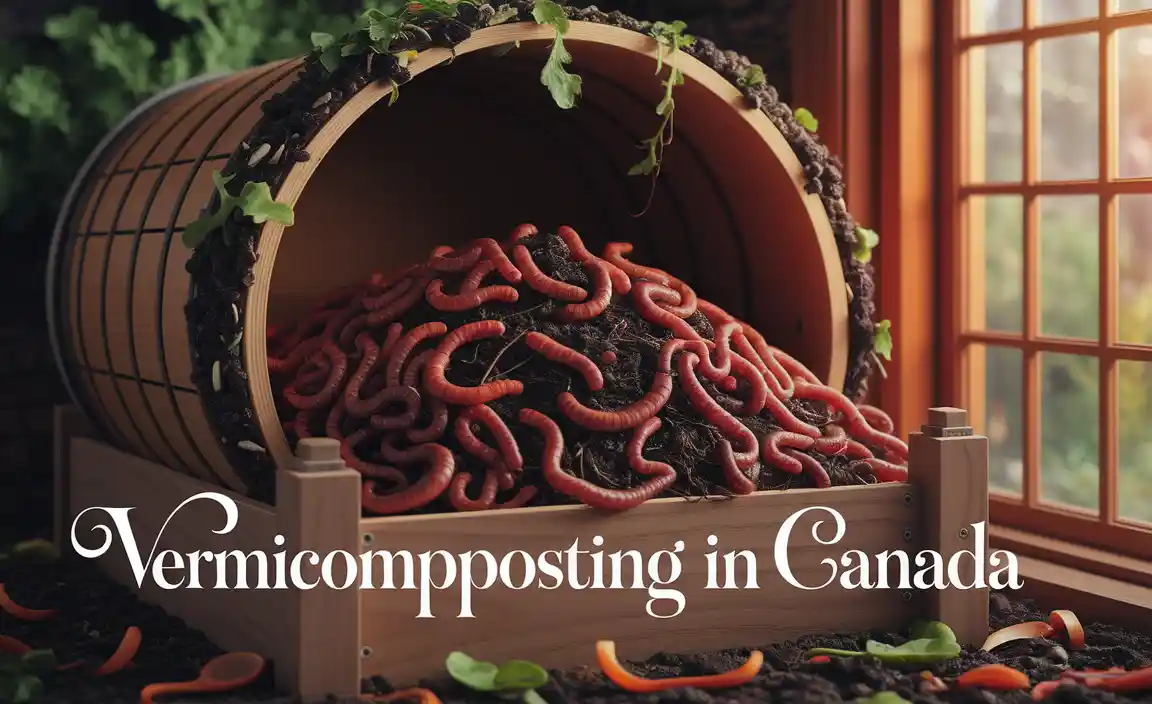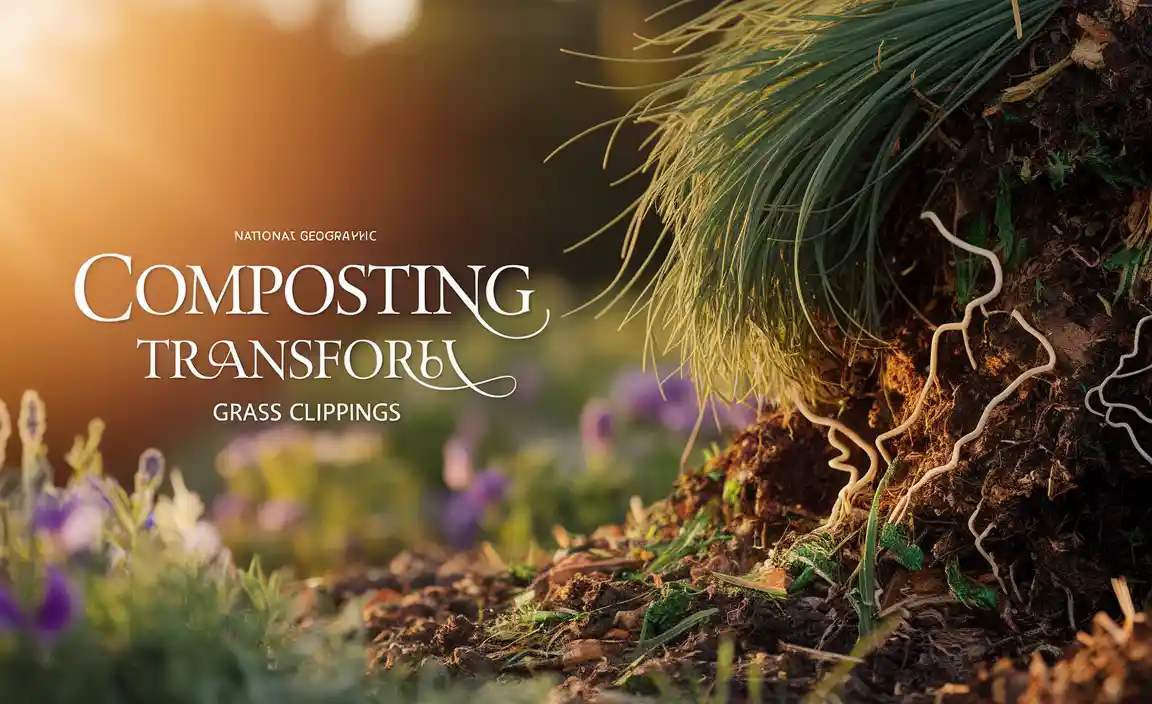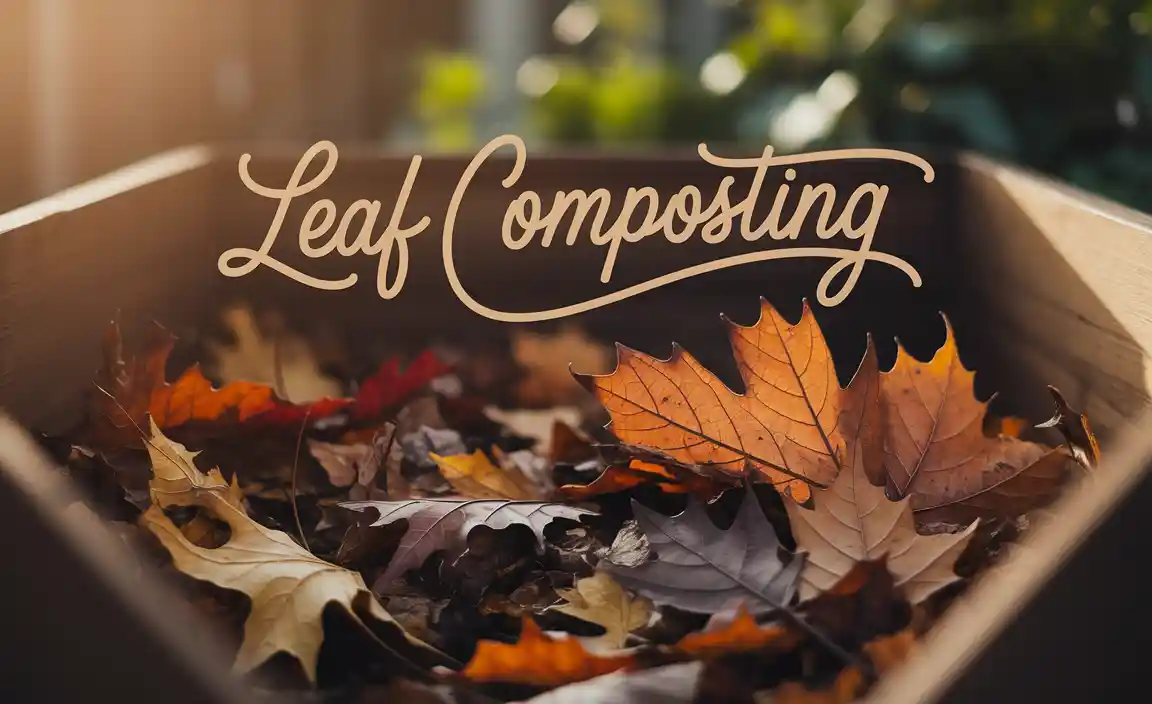Hey there, fellow gardeners and tree lovers! Ever wonder what to do with all that compost you’ve been making? If you’ve got fruit trees in your backyard – or are dreaming of planting some – then you’re in for a treat. Feeding your orchard the right way is super important, and compost is like nature’s multivitamin for your trees. But how do you give it to them effectively? Let’s ditch the confusion and get down to the simple, proven ways to use compost to make your orchard thrive. We’ll cover everything you need to know, from knowing how much to use to the best times for applying it.
Compost For Orchards: Giving Your Trees the Best Food
As Troy D Harn from TopChooser, I love finding the easiest, most effective ways to make things grow. And when it comes to our precious fruit trees, compost is pure gold. It’s not just about adding nutrients; it’s about improving the very soil your trees depend on. Think of it as giving your trees a healthy, happy home that will reward you with more delicious fruit for years to come. This guide is all about making it super simple to use compost correctly for a happy, healthy, and productive orchard. We’ll explore the best uses, answer common questions, and make sure you feel totally confident in feeding your trees the good stuff.
Using compost in your orchard is one of the most rewarding things you can do for your trees. It’s a natural, sustainable way to feed them, improve your soil health, and ultimately get more tasty fruit. Forget fancy fertilizers for a moment; compost is the foundation of a truly robust and healthy orchard ecosystem.
Why Compost is a Superfood for Orchard Trees
Compost is more than just decomposed organic matter; it’s a living soil amendment teeming with beneficial microbes. These tiny helpers work tirelessly to break down nutrients, making them available to your trees. But that’s just the beginning. Here’s why compost is a game-changer:
- Nutrient Rich: Compost slowly releases a balanced blend of essential nutrients that fruit trees need to grow strong and produce good fruit.
- Improves Soil Structure: It helps sandy soil hold more water and nutrients, and it loosens up heavy clay soil, allowing better air and water circulation.
- Boosts Microbial Activity: A healthy soil microbiome is crucial for tree health. Compost introduces beneficial bacteria and fungi that can fend off diseases and help trees absorb nutrients.
- Water Retention: Compost acts like a sponge, so your soil holds onto moisture longer, reducing the need for frequent watering, especially during dry spells.
- pH Balance: It can help buffer soil pH, making it more neutral and suitable for a wider range of fruit trees.
Understanding Your Orchard Soil
Before we dive into the ‘how-to,’ it’s always a good idea to give your soil a friendly check-up. Knowing your soil type (sandy, clay, loamy) and its general health can help you tailor your compost application. A simple soil test, which you can often get from your local cooperative extension office, can reveal nutrient levels and pH. This isn’t strictly necessary for basic composting, but it’s a great way to really dial in your orchard care. For more about soil testing, check out resources from institutions like USDA Natural Resources Conservation Service, they have great info on soil health.
Proven Best Uses of Compost in Your Orchard
So, you’ve got your compost ready. Now, where does it go and how much should you use? It’s all about applying it smartly for the best results. We’ll break down the most effective ways to get that compost working for your fruit trees.
1. The Soil Amendment Powerhouse
This is the most foundational and beneficial use of compost. Before planting a new tree, or as ongoing maintenance for established trees, working compost into the soil is key. It’s all about improving the environment where the roots live.
For New Tree Plantings:
When digging the hole for a new tree, mix compost with the excavated soil. A common recommendation is to mix around 25-30% compost with 70-75% native soil.
- Dig your hole twice as wide as the tree’s root ball and about as deep.
- Break up the soil you removed with a shovel or garden fork.
- Add a generous amount of finished compost to the soil you excavated.
- Mix the soil and compost thoroughly.
- Place the tree in the hole, backfill with your compost-soil mixture, and water well.
For Established Trees:
You don’t need to dig around established trees too much. Simply spread a layer of compost on top of the soil.
- Where to Apply: Spread the compost from the tree’s trunk out to the drip line (the edge of the canopy where water would naturally fall from the leaves). Avoid piling compost directly against the trunk, as this can encourage rot and pests.
- How Much: For mature trees, a layer of 2 to 4 inches is often recommended. For younger trees, 1 to 2 inches is usually sufficient.
- Application Time: Spring is a fantastic time to apply compost to established trees as they are waking up and starting their growing season. You can also apply it in the fall.
2. Top-Dressing Around Trees
This is a simpler version of soil amendment for established trees. Instead of digging, you’re essentially layering compost on top, letting nature do the work of incorporating it over time. It’s much gentler on the root system.
The Process:
- Gather your finished compost. Ensure it’s well-rotted and doesn’t smell bad.
- Gently spread a layer, about 1-3 inches deep, over the soil surface.
- Keep the compost a few inches away from the tree trunk to prevent moisture buildup and potential disease issues.
- Extend the application out to the tree’s drip line – this is where most of the feeder roots are.
- Water the area gently after application. Rain will also help break it down and move nutrients into the soil.
This method is excellent for improving soil surface conditions, feeding beneficial soil organisms, and providing a slow release of nutrients without disturbing the existing root structure.
3. Mulching for Moisture and Weed Suppression
Compost makes a fantastic mulch! While wood chips or straw are common mulches, compost offers the added benefit of slowly feeding your soil as it breaks down. It helps conserve moisture, suppress weeds, and regulate soil temperature.
Benefits of Compost as Mulch:
- Conserves Water: It reduces evaporation from the soil surface.
- Suppresses Weeds: A good layer of compost blocks sunlight, making it harder for weeds to sprout.
- Regulates Soil Temperature: Keeps roots cooler in summer and warmer in winter.
- Feeds Soil Organisms: Earthworms and microbes love munching on compost.
- Slow Nutrient Release: As it decomposes, it adds nutrients directly to the topsoil.
How to Use:
Apply a 2-4 inch layer of compost around your trees, extending to the drip line. Just like with top-dressing, keep it a few inches away from the trunk.
4. Boosting Seedling and Young Tree Growth
For brand new additions to your orchard, especially saplings or trees planted from seed, compost is crucial for giving them the best possible start. It provides the gentle, nutrient-rich environment young roots need to establish themselves.
In the Nursery Bed or Pot:
If you’re starting trees from seed or young transplants, mix a good proportion of compost into your potting mix or nursery bed soil. A ratio of 1 part compost to 3 parts good quality soil or potting mix is a great starting point.
Newly Planted Saplings
After planting a young sapling, using compost as both an amendment in the planting hole and as a top dressing around it provides immediate benefits. This helps ensure that those vulnerable first few years of growth are supported by excellent soil conditions.
5. Compost Tea for Foliar Feeding (Advanced, but Easy!)
While not directly applying solid compost, compost tea is a liquid extract that can deliver beneficial microbes and soluble nutrients directly to the leaves and roots. It’s a fantastic way to give your trees a quick pick-me-up.
What is Compost Tea?
It’s essentially brewed compost, made by steeping finished compost in water, often with aeration and sometimes with added sugars to feed the microbes. The resulting liquid is rich in beneficial microorganisms.
How to Use:
- Brew it: Use a compost tea brewer or a simple bucket with an aquarium pump to aerate water with compost for 24-48 hours.
- Apply: Strain the tea and apply it as a foliar spray (on leaves) or drench the soil around the base of the trees.
- Timing: Early morning or late evening is best, when the sun is not too strong, to prevent leaf scorch and allow for maximum absorption.
This method is great for a quick boost of microbial activity and nutrients for trees that might be showing signs of stress or nutrient deficiency. For a detailed guide, resources from university extension programs often have great instructions on brewing compost tea.
How Much Compost to Use? A Simple Guide
Figuring out the right amount of compost can seem tricky, but it’s really about understanding the coverage area and the ‘why’ behind it. The goal isn’t to bury your trees in compost, but to augment the soil effectively.
Here’s a simple breakdown:
| Application Method | Application Area | Amount of Compost | Target Tree Stage |
|---|---|---|---|
| Soil Amendment (New Planting) | Mixed into planting hole soil | 25-30% of excavated soil volume | New plantings |
| Top-Dressing / Mulching | Surface, from trunk to drip line (avoiding trunk) | 1-2 inches for young trees; 2-4 inches for mature trees | Established trees, all ages |
| Potting Mix / Nursery Beds | Mixed with soil or potting medium | 20-25% of total volume | Seedlings, young transplants |
| Compost Tea (Foliar/Soil Drench) | Spritzed on leaves or watered into soil | Diluted liquid, follow brewing instructions | All tree ages, for a quick boost |
Remember, this is about adding to your soil, not replacing it. Over-application isn’t necessarily ‘more is better’ and can sometimes lead to issues like too much water retention or nutrient imbalances. It’s always better to apply compost regularly in smaller amounts than in one giant application.
The ‘Drip Line’ Explained
You’ll hear me mention the ‘drip line’ a lot when talking about applying anything to your trees. It’s simply the outermost edge of the tree’s branches – envision a line on the ground where rainwater would drip from the leaves. This is crucial because this is where the majority of a tree’s active feeder roots are located. Applying compost and mulch out to this line ensures you’re feeding the most critical part of the tree’s root system.
What Kind of Compost Works Best?
For orchard use, the best compost is fully finished, mature compost. This means it’s dark, crumbly, smells earthy (not sour or like ammonia), and you can barely recognize the original materials. Immature compost can tie up nitrogen, making it unavailable for your trees, and may contain weed seeds or pathogens.
You can use compost made from:
- Kitchen scraps (vegetable peels, coffee grounds, eggshells – avoid meat and dairy for home composting)
- Yard waste (leaves, grass clippings in moderation, shredded branches)
- Manure (from herbivores like horses, cows, chickens – ensure it’s aged or composted properly to kill pathogens)
- A combination of these!
If you’re buying compost, look for bagged compost labeled as “organic” or “high-quality compost” from reputable garden centers or landscape suppliers.
When to Apply Compost to Your Orchard
Timing is everything, and applying compost at the right moment can maximize its benefits for your fruit trees.
Spring Application
This is arguably the most popular and beneficial time to apply compost. As your trees come out of dormancy and begin their new growth cycle, they can immediately utilize the nutrients and improved soil conditions.
- Benefits: Provides a nutrient boost for flowering and fruit development. Improves soil moisture retention as temperatures rise.
- How-to: Spread compost around the drip line and lightly water. You can also incorporate it into the soil surface.
Fall Application
Applying compost in the fall is also highly beneficial. It gives the compost time to break down over the winter, and the beneficial microbes can continue working in the milder soil temperatures. It also prepares the soil for spring.
- Benefits: Protects roots from winter extremes. Allows slow breakdown and nutrient release for early spring uptake. Improves soil structure over winter’s freeze-thaw cycles.
- How-to: Spread a layer of compost around the base of the trees, extending to the drip line. It will naturally integrate into the soil with winter weather.
Other Times
While spring and fall are ideal, you can apply compost at other times of the year if needed, especially on young trees or those showing deficiency. However, avoid applying heavy layers during the peak of summer heat, as it can sometimes lead to excessive moisture retention that might stress roots in very hot conditions, unless you are watering diligently.
Common Mistakes to Avoid
Even with something as forgiving as compost, there are a few common pitfalls that can reduce its effectiveness or, in rare cases, cause minor issues. Let’s steer clear of these:
- Piling compost against the trunk: This is a big one. It holds moisture against the bark, inviting fungal diseases and pests like borers. Always keep a few inches of space.
- Using immature compost: As mentioned, this can harm your trees. Ensure your compost is fully “cooked.”
- Applying too much at once: While compost is gentle, excessive amounts can lead to overly wet soil or nutrient imbalances. Regular, moderate applications are best.
- Not watering it in: Especially if you’re applying a thick layer in dry weather, a good watering helps settle the compost and start the integration process.
- Applying compost to lawns around trees instead of the soil: The compost needs to reach the tree’s roots. Simply spreading it on turfgrass might not deliver the full benefit directly to your trees unless it’s a very thin layer or you ensure it can seep down.
FAQ for Orchard Compost Beginners
Q1: Can I use fresh manure as compost for my orchard?
A1: It’s best to avoid using fresh, uncomposted manure directly around fruit trees. Fresh manure can be too “hot” (high in salts and ammonia), potentially burning tree roots. It can also contain weed seeds and pathogens. Always use well-aged manure or compost that has been made from manure, which has broken down its harmful components.
Q2: How far away from the tree trunk should I spread compost?
A2: For both young and mature trees, keep the compost at least a few inches away from the trunk. For larger, mature trees, you can leave 6-12 inches of clear space around the immediate trunk area. This helps prevent moisture buildup against the bark, which can lead to rot and disease.
Q3: My compost has a lot of weed seeds. Is it still okay to use?
A3: If your compost is not fully finished, it might contain viable weed seeds. While the goal is to improve your soil, you don’t want to introduce a weed problem. If you know your compost is immature, consider using it in a separate compost pile to let it mature further, or be prepared to do more weeding in those areas. Higher quality compost piles that get hot enough during the composting process will kill most weed seeds.
Q4: Do I need to till or dig the compost into the soil every time?
A4: No, you don’t always have to dig it in. Top-dressing and mulching with compost are very effective methods. Earthworms and soil microbes will naturally work the compost into the soil over time. Tilling can

I am passionate about home engineering. I specialize in designing, installing, and maintaining heating, ventilation, and air conditioning systems. My goal is to help people stay comfortable in their homes all year long.



